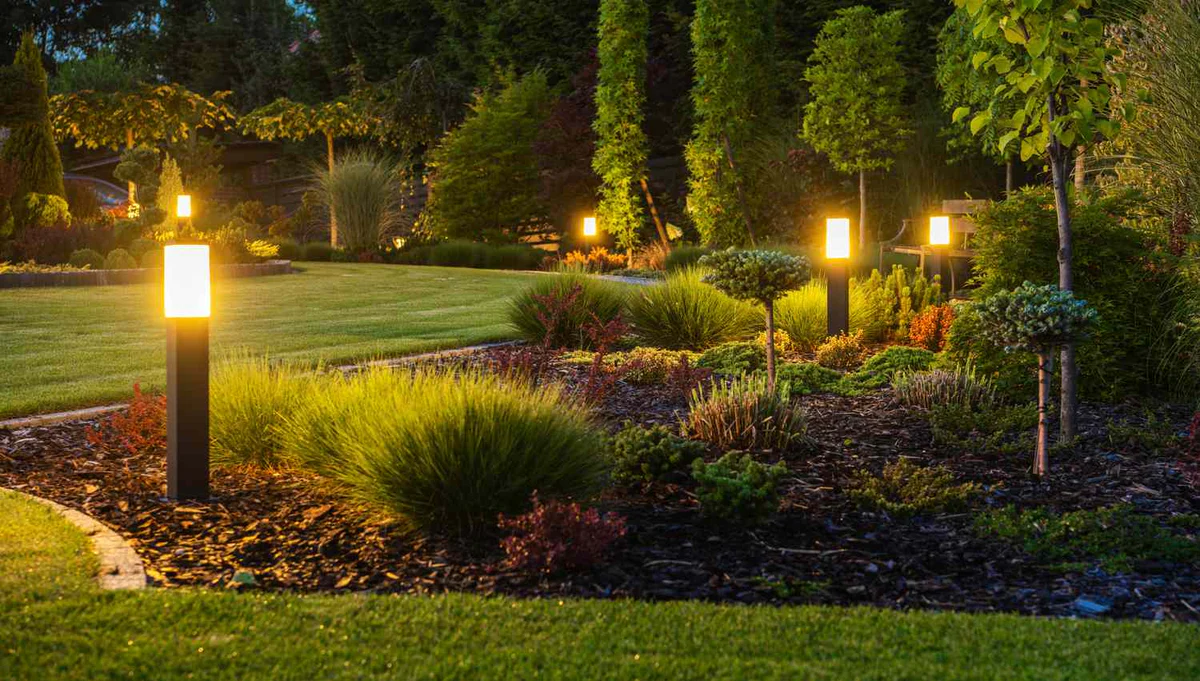Illuminate Your Outdoor Space: 12 Transformative Garden Lighting Ideas for Every Landscape
Creating a thoughtfully illuminated garden extends your outdoor enjoyment well beyond sunset, transforming your landscape into a magical nighttime retreat. Strategic lighting not only enhances safety and security but also showcases your garden’s best features while creating an entirely new aesthetic dimension after dark. Whether you have a sprawling landscape or a compact urban patio, the right lighting approach can dramatically elevate your outdoor living experience.
Understanding the Fundamentals of Outdoor Lighting Design
Before diving into specific ideas, it’s important to establish a foundation in lighting design principles that will guide your garden illumination project.
“The most successful garden lighting creates a balanced composition of light and shadow,” explains Janet Lennox Moyer, landscape lighting designer and author of “The Landscape Lighting Book.” “Many homeowners make the mistake of over-lighting their gardens, which flattens the landscape and eliminates the mystery that makes nighttime gardens so enchanting.”
The three essential lighting techniques to master include:
Uplighting: Positioning fixtures at ground level to illuminate trees, architectural elements, or garden features from below, creating dramatic shadows and highlighting textures.
Downlighting: Mounting fixtures above to cast light downward, mimicking natural moonlight when placed in trees or on structures.
Path lighting: Low-level illumination that guides movement through the landscape while enhancing safety.
The most effective garden lighting designs incorporate all three techniques to create layers of light that add depth and dimension to your outdoor space.
Small Garden Lighting Ideas: Maximizing Impact in Limited Spaces
When working with compact outdoor areas, every lighting element must serve multiple purposes without overwhelming the space. These approaches are particularly effective in urban gardens, balconies, and courtyards.
1. Vertical Illumination for Perceived Spaciousness
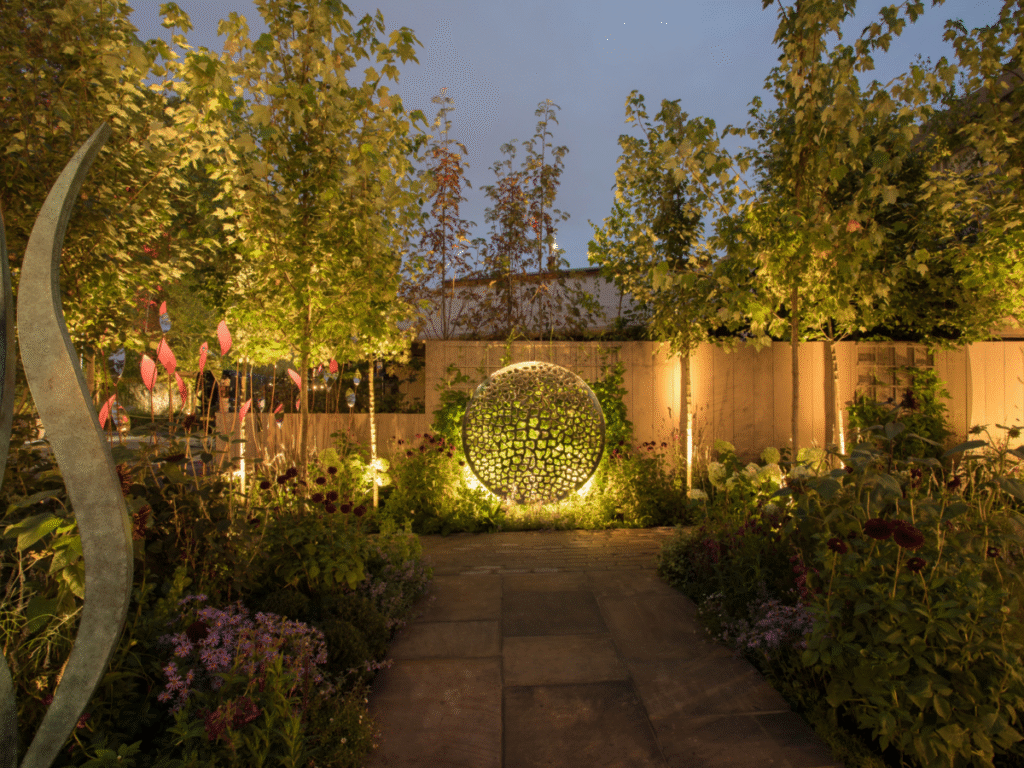
In small gardens, directing light upward along walls, fences, or tall plants creates the illusion of expanded space. Wall-washing techniques, where fixtures placed at the base of boundary walls cast an even glow upward, visually push boundaries outward and make the area feel more expansive.
“In urban gardens, I often use narrow-beam uplights against textured surfaces to maximize the perception of space,” notes landscape architect Margaret Fletcher of Urban Green Spaces. “The interplay of light and shadow on vertical surfaces draws the eye upward and outward, counteracting the confined footprint.”
Materials with interesting textures—weathered wood, stone, or plants with architectural foliage like ornamental grasses or bamboo—become dynamic features when strategically illuminated from below.
2. Multi-Functional Lighting Elements
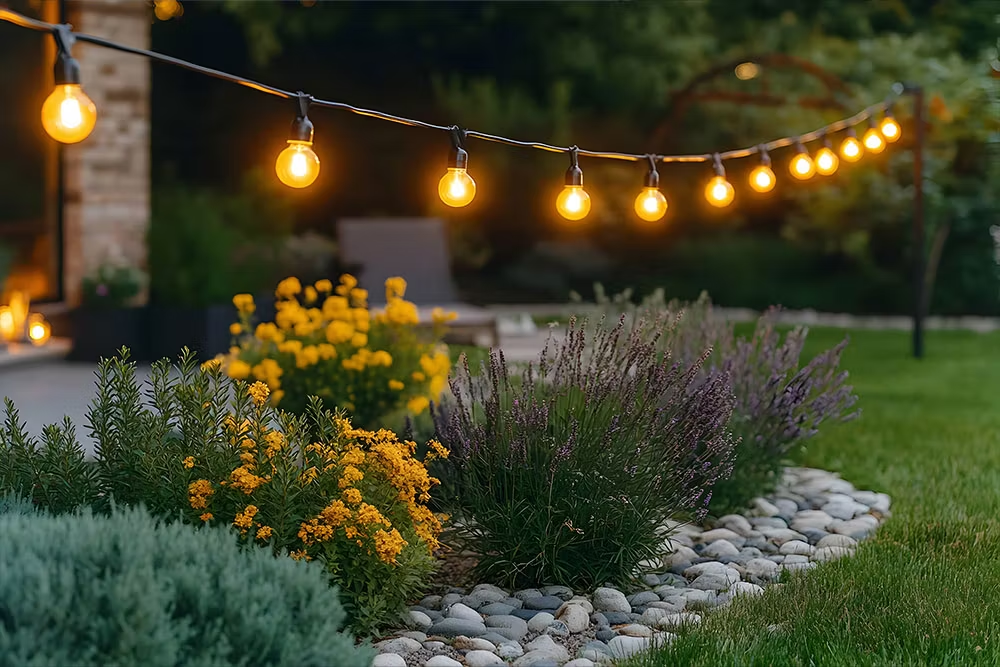
For small gardens, choose fixtures that provide both practical illumination and serve as decorative elements during daylight hours. Consider:
- Solar-powered lanterns that double as sculptural pieces
- Illuminated planters that combine greenery and gentle ambient light
- Bistro light canopies that create an overhead plane without consuming floor space
- Built-in bench lighting that defines seating areas while preserving precious square footage
Lauren Brooks of Small Space Gardens recommends “choosing lighting elements with clean, simple designs that complement rather than compete with your plantings. In compact spaces, visual clutter quickly becomes overwhelming, so select lighting with intentional restraint.”
3. Reflective Surfaces to Amplify Light
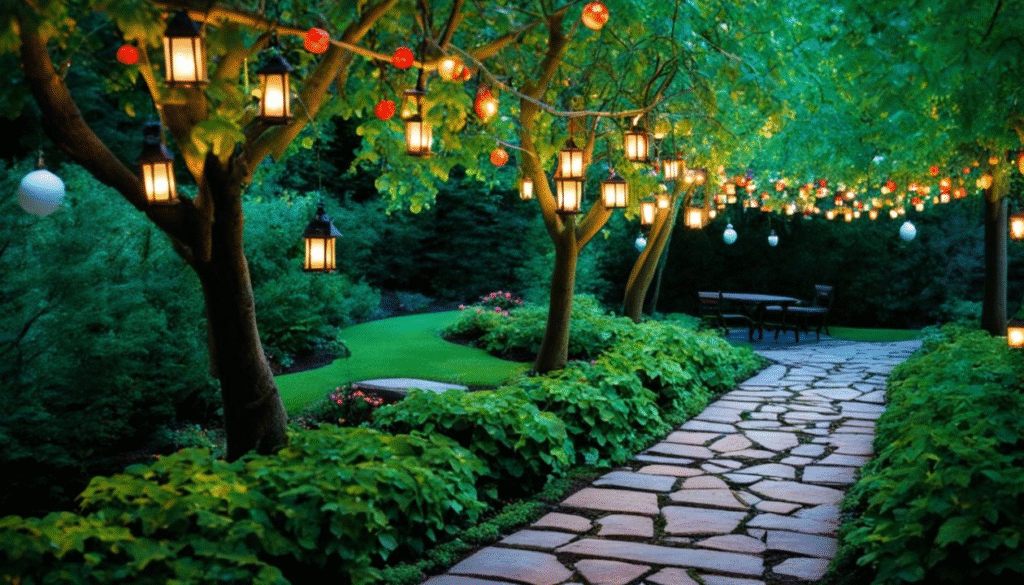
Strategically incorporate reflective elements to multiply the impact of limited lighting fixtures:
- Water features that capture and ripple light
- Mirrors positioned to reflect illuminated garden vignettes
- Light-colored paving materials that bounce ambient light upward
- Metallic planters or garden art that glimmers even with minimal illumination
“A small reflecting pool with a simple underwater light creates movement and amplifies brightness, effectively doubling your lighting investment,” explains water feature specialist David Robinson.
Landscape Garden Lighting Ideas: Creating Depth and Drama
For larger landscapes with diverse planting areas, architectural elements, and outdoor living spaces, a comprehensive lighting approach can transform how you experience and enjoy your property after dark.
4. Layered Lighting Zones for Outdoor Rooms
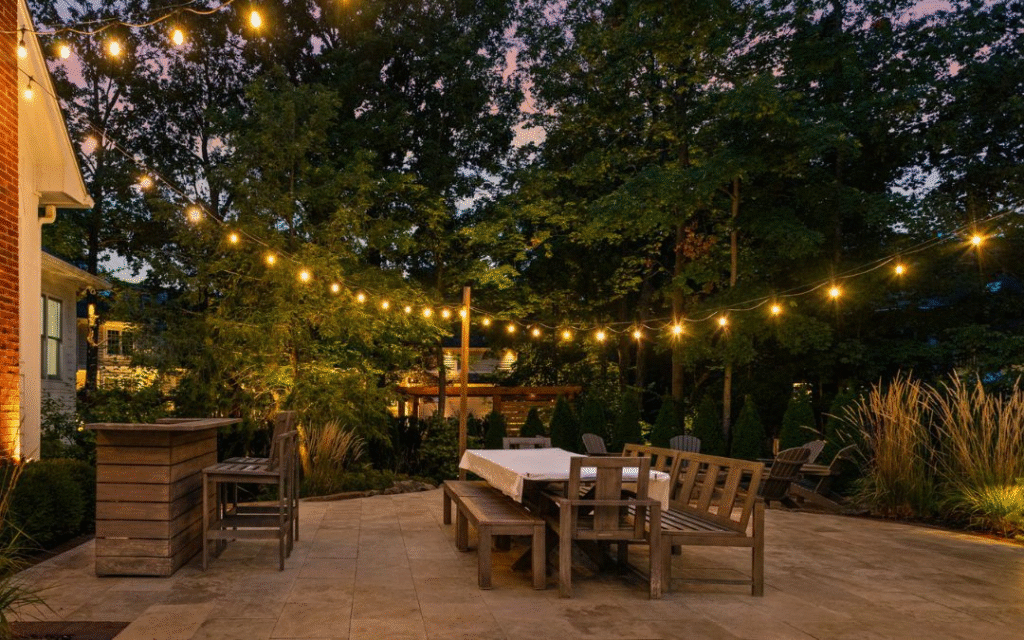
Just as interior designers create layers of light within homes, your garden benefits from distinct lighting zones that define functional areas while creating visual flow.
Create a lighting plan that addresses these key zones:
- Entertaining areas: Combine overhead string lights or pendants with tabletop lanterns for adjustable brightness levels
- Transitional pathways: Use subtle path lights to guide movement between areas
- Focal points: Highlight specimen trees, water features, or garden art with precisely aimed spotlights
- Perimeter security: Softer perimeter lighting that defines boundaries without harsh glare
“The most successful landscape lighting plans create a rhythmic experience as you move through the garden,” says lighting designer Janet Lennox Moyer. “Alternating between brighter activity nodes and more subtly lit transitional spaces creates a natural flow that draws people through the landscape.”
5. Highlighting Specimen Trees and Architectural Plants
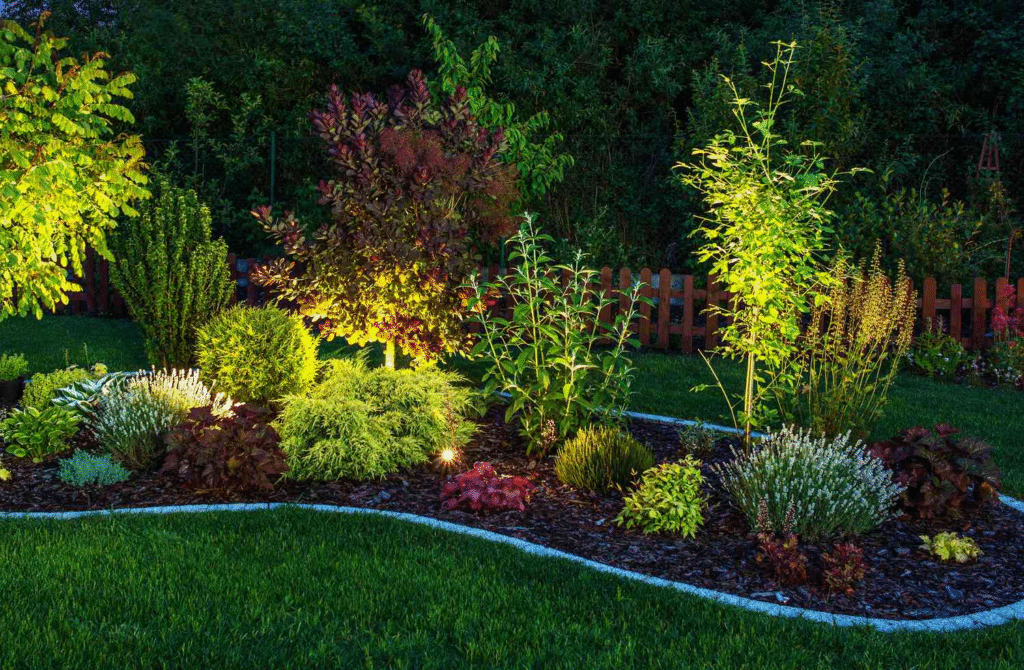
Trees and sculptural plants become dramatic nighttime features with proper illumination techniques:
- Cross-lighting: Position two fixtures at different angles to eliminate flat, one-dimensional shadows
- Moonlighting: Place downlights high in tree canopies to cast dappled shadows resembling natural moonlight
- Silhouetting: Place lights behind distinctive plant forms to create dramatic dark outlines against illuminated backgrounds
- Grazing: Position lights at sharp angles to emphasize textured bark or architectural branches
“When illuminating specimen trees, consider their seasonal changes,” advises certified arborist Michael Jenkins. “Deciduous trees may require adjusted lighting techniques between summer and winter to account for foliage density changes.”
6. Water Feature Illumination
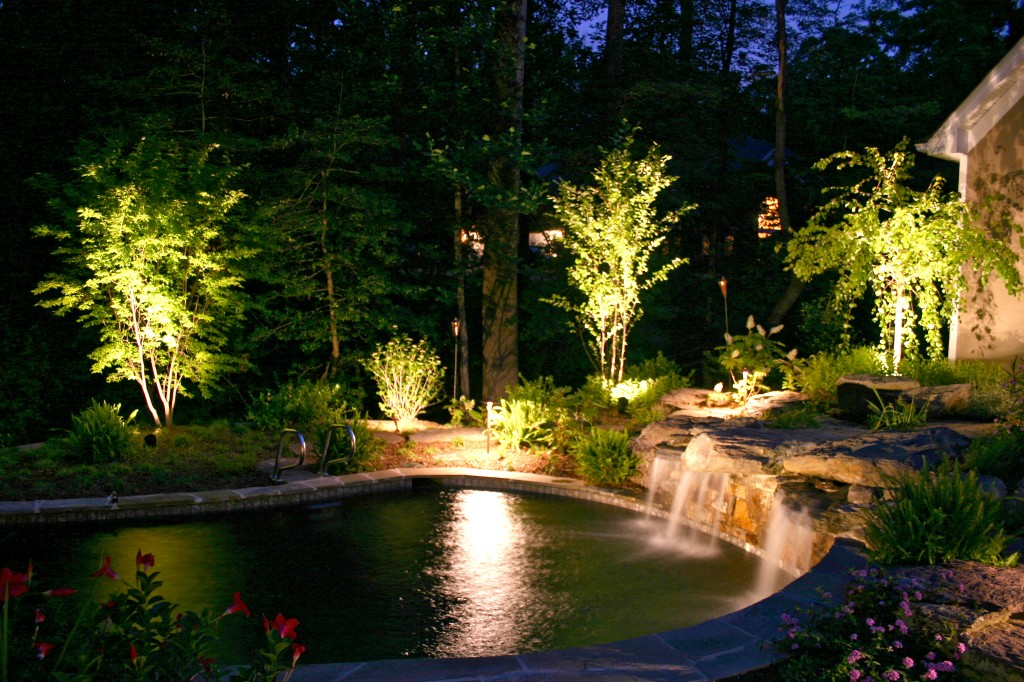
Water elements become particularly magical when lit at night, with light reflecting and amplifying across moving surfaces:
- Submersible LED lights for ponds and reflection pools
- Illuminated spillways and fountain jets
- Backlit waterfalls that glow from within
- Floating solar orbs for temporary special occasion lighting
“When lighting water features, less is often more,” cautions water garden specialist Jennifer Zuri. “A single well-placed underwater light can create more drama than multiple competing fixtures that flatten the water’s surface movement.”
7. Seasonal Lighting Strategies
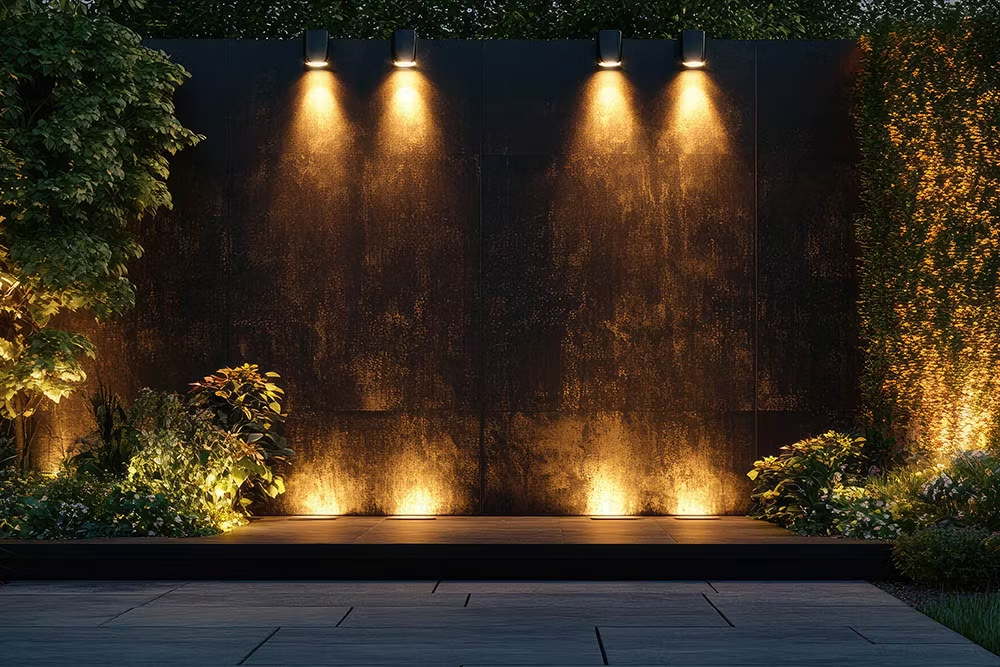
Develop lighting approaches that evolve with your garden’s seasonal changes:
- Spring: Highlight flowering trees and bulb displays with adjustable spotlights
- Summer: Illuminate outdoor dining and entertainment areas for extended evening use
- Fall: Adjust fixtures to capture autumn foliage color and textural changes
- Winter: Emphasize structural elements, evergreens, and architectural features when deciduous plants are dormant
“I recommend clients invest in a lighting system with programmable zones that can be adjusted seasonally,” explains landscape designer Thomas Rainer. “This allows the lighting scheme to evolve as the garden changes throughout the year.”
Exterior Garden Lighting Ideas: Enhancing Architecture and Landscape Integration
The most successful exterior lighting creates harmonious connections between built structures and surrounding landscapes, enhancing both elements while improving functionality.
8. Architectural Accent Lighting
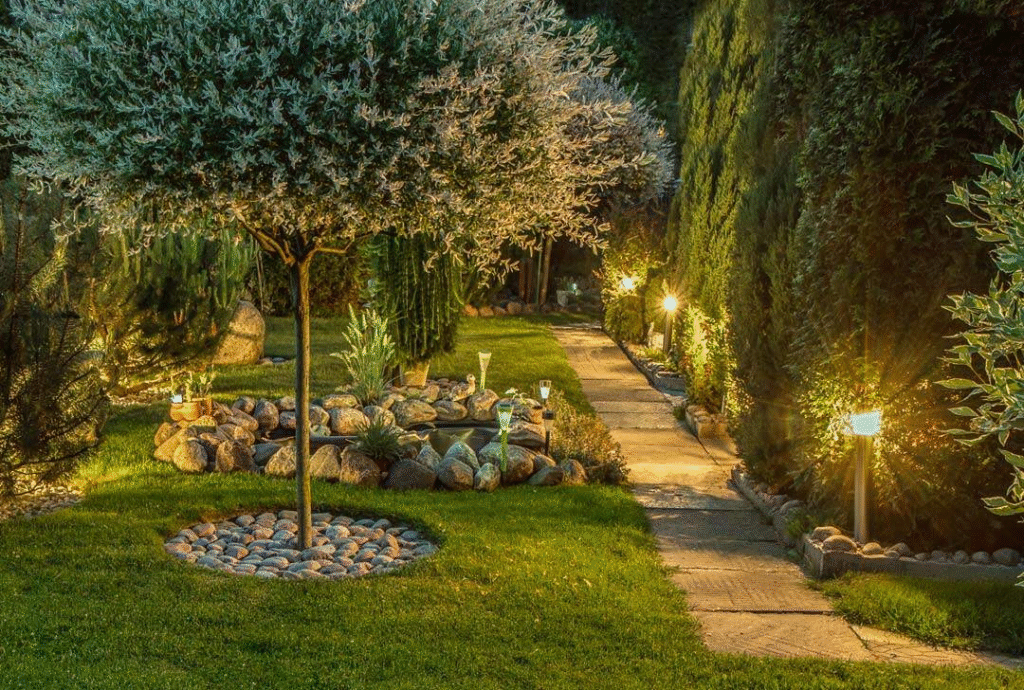
Illuminate your home’s distinctive architectural features to create a backdrop for your garden lighting:
- Gentle washing of façade textures
- Highlighting of columns, eaves, or decorative elements
- Grazing stone or brick walls to emphasize texture
- Softly illuminating entry areas for both welcome and security
“The house should never compete with the garden lighting,” advises architectural lighting designer Marcus Steffen. “Instead, they should complement each other with the home often serving as a subtly lit backdrop that grounds the landscape lighting.”
9. Hardscape Integration for Seamless Transitions
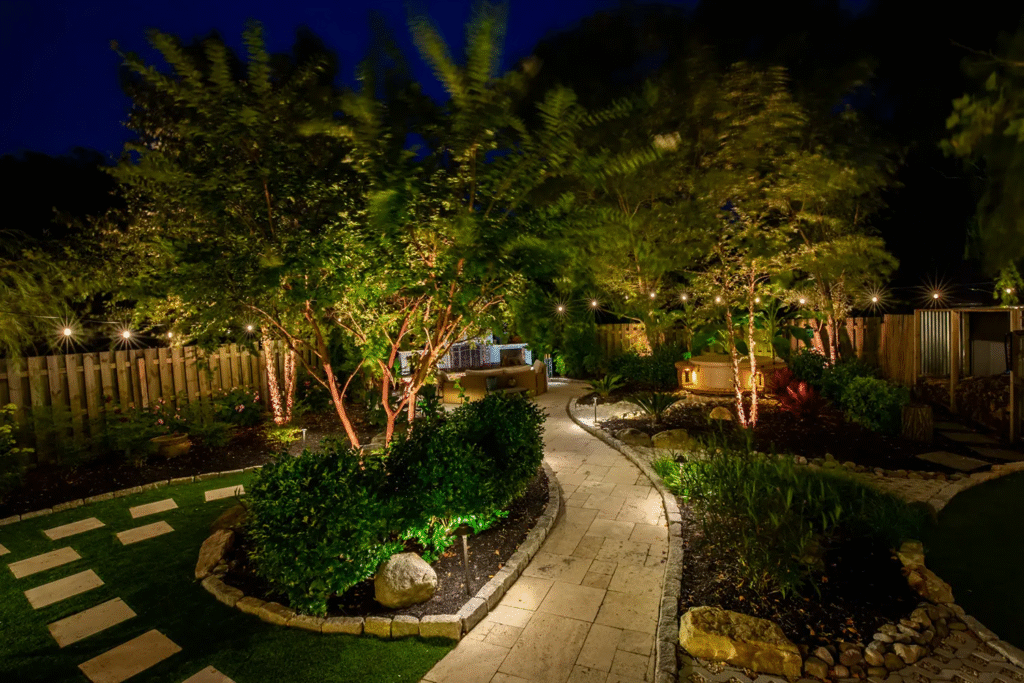
Incorporate lighting directly into hardscape elements for subtle illumination that appears as a natural part of the landscape:
- LED strip lighting recessed into steps for safety and visual effect
- Under-cap lighting for walls, pillars, and raised planters
- Integrated fixtures within decking or paving systems
- Illuminated handrails that combine safety and aesthetic appeal
“Integrated lighting should appear as if the hardscape elements themselves are glowing rather than being illuminated by visible fixtures,” notes hardscape specialist Rebecca Wilson. “This creates a more sophisticated, less utilitarian appearance.”
10. Sustainable and Smart Lighting Solutions
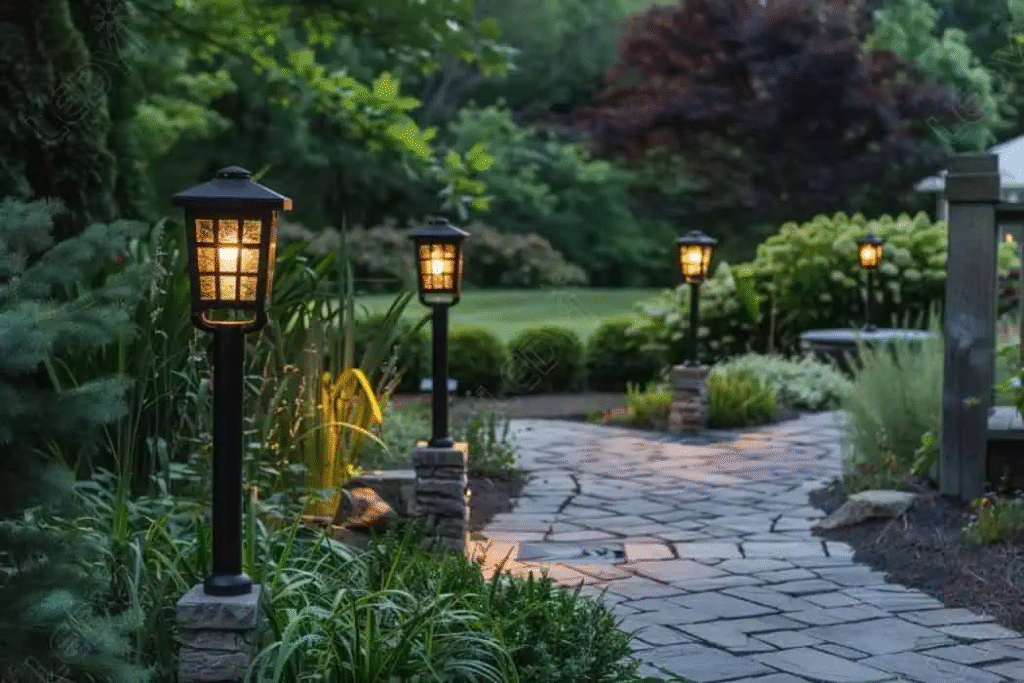
Embrace energy-efficient technologies and intelligent controls that reduce environmental impact while enhancing functionality:
- Solar-powered pathway lights for areas distant from electrical sources
- LED systems that consume 80% less energy than incandescent alternatives
- Smart controllers allowing zone-specific programming and dimming capabilities
- Motion sensors for security areas that activate only when needed
“Today’s solar lighting options have dramatically improved in both light quality and reliability,” explains sustainable landscape designer Michael Pascoe. “High-quality solar fixtures can now provide consistent performance even in regions with variable sun exposure.”
Best Outdoor Landscaping Lighting: Professional Techniques for DIY Success
Adopt these professional-grade approaches to elevate your garden lighting from basic to extraordinary:
11. Professional Planning Process

Follow this systematic approach used by lighting designers to create cohesive, effective garden illumination:
- Create a base map: Document existing structures, pathways, key plants, and outdoor living spaces
- Identify focal points: Determine primary features worthy of emphasis
- Establish movement patterns: Map how people navigate through your landscape at night
- Layer lighting types: Plan where to apply uplighting, downlighting, and path lighting
- Select appropriate fixtures: Choose fixtures based on specific applications, not just aesthetic appeal
- Consider power sources: Determine electrical access points and requirements
- Create control zones: Group fixtures logically for independent operation
“The most common mistake homeowners make is purchasing fixtures before developing a comprehensive lighting plan,” cautions landscape lighting designer Janet Lennox Moyer. “This leads to haphazard placement and ineffective results.”
12. Technical Considerations for Long-Term Success
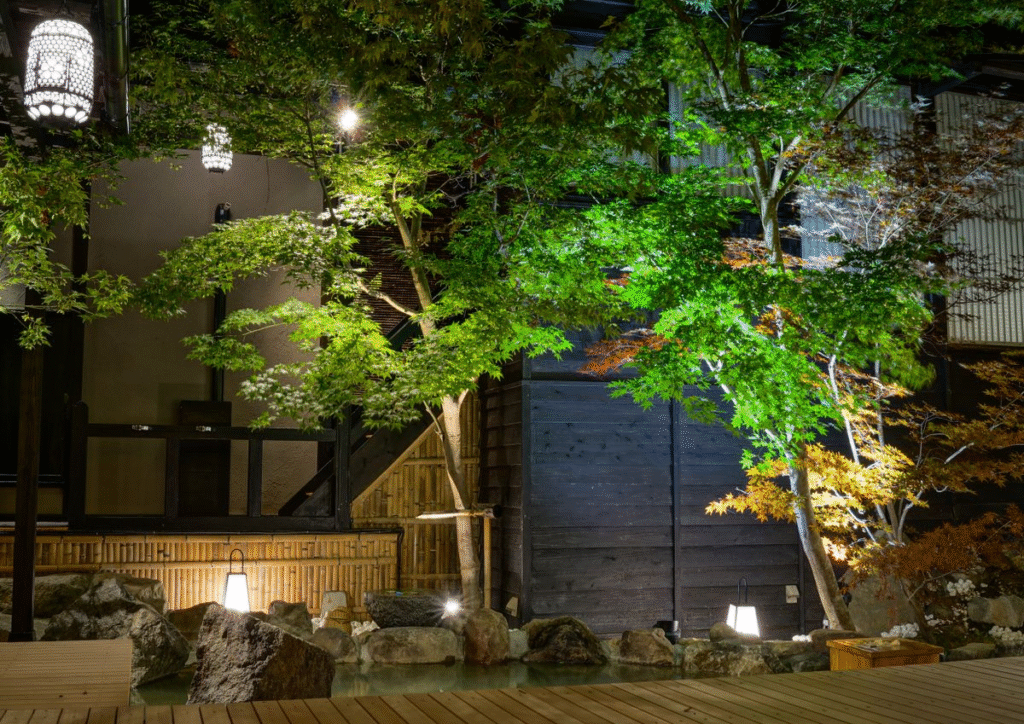
Ensure your lighting installation performs beautifully for years with these professional considerations:
- Voltage drop calculations: Ensure consistent brightness across distance
- Appropriate wire sizing: Select proper gauge for your system’s requirements
- Weatherproof connections: Use only outdoor-rated junction systems
- Future-proofed installation: Install extra conduit for potential system expansion
- Seasonal adjustments: Reposition fixtures as plants grow or garden features evolve
- Fixture quality: Invest in commercial-grade materials (brass, copper) for fixtures in harsh weather exposures
“I always advise clients that investing in quality infrastructure—wiring, transformers, and connections—is more important than the fixtures themselves,” notes electrical contractor Susan Johnson. “Fixtures can be upgraded over time, but poor infrastructure requires disruptive reinstallation.”
Creating Your Garden Lighting Plan: A Step-by-Step Approach
Ready to transform your own outdoor space with professional-quality lighting? Follow this practical implementation process:
Assessment Phase
- Photograph your garden from multiple angles during daylight
- Visit your garden at dusk to identify areas that naturally fall into shadow
- Identify primary viewing perspectives (from inside your home, main patio areas)
- List key features worthy of highlighting
- Determine your primary lighting goals (security, aesthetics, or specific activities)
Design Phase
- Sketch a basic lighting plan on a simple garden map
- Calculate power requirements for your desired fixtures
- Research fixture options for each application
- Create a phased implementation plan if working with budget constraints
- Consider consulting with a lighting professional for a one-time design consultation
Implementation Phase
- Start with a small test area to refine techniques
- Install infrastructure (power sources, wiring) with future expansion in mind
- Position fixtures temporarily before permanent installation
- View test lighting from multiple perspectives at night
- Adjust and refine before finalizing positions
“I recommend clients experiment with temporary lighting solutions before committing to permanent installation,” suggests landscape designer Scott Cohen. “Simple solar stake lights or even flashlights positioned strategically can help visualize effects before investing in permanent fixtures.”
Maintenance and Evolution
Remember that garden lighting is not a static installation but evolves with your landscape:
- Schedule quarterly inspection of fixtures and connections
- Clean lenses and adjust aim seasonally as plant growth changes
- Update programming for seasonal variations in daylight hours
- Evaluate lighting performance during different weather conditions
- Consider refreshing your lighting scheme every 3-5 years as technology and your garden evolve
Environmental Considerations
As you enhance your garden with lighting, maintain ecological sensitivity:
- Use fully shielded fixtures to reduce light pollution
- Choose warm-temperature LEDs (2700-3000K) that minimize wildlife disruption
- Install timers to reduce unnecessary nighttime illumination
- Consider dark-sky compliant fixtures in rural or sensitive ecological areas
- Use zoned controls to illuminate only areas in active use
“Responsible garden lighting enhances human enjoyment while respecting wildlife needs,” emphasizes ecological landscape designer Claudia West. “Limiting lighting duration and intensity to only what’s necessary creates a more sustainable approach.”
Conclusion: Your Illuminated Garden Journey
Thoughtful garden lighting transforms your outdoor space into an enchanting nighttime environment that extends your enjoyment of nature well beyond daylight hours. By approaching your lighting design with intention—considering scale, purpose, technical requirements, and ecological impact—you create an outdoor experience that captivates throughout the seasons.
Whether you’re enhancing a compact urban garden or illuminating an expansive landscape, the principles remain consistent: thoughtful planning, appropriate technology, and artistic implementation combine to create magical outdoor environments after dark. Your illuminated garden becomes not just an extension of your living space but a distinctive nighttime landscape that reveals new beauty when the sun sets.
Ready to begin your garden lighting journey? Start small, experiment freely, and let your garden’s natural features guide your illumination choices. The most successful garden lighting feels like a natural evolution of your landscape’s daytime persona—revealing hidden dimensions while creating entirely new opportunities for outdoor enjoyment.
